
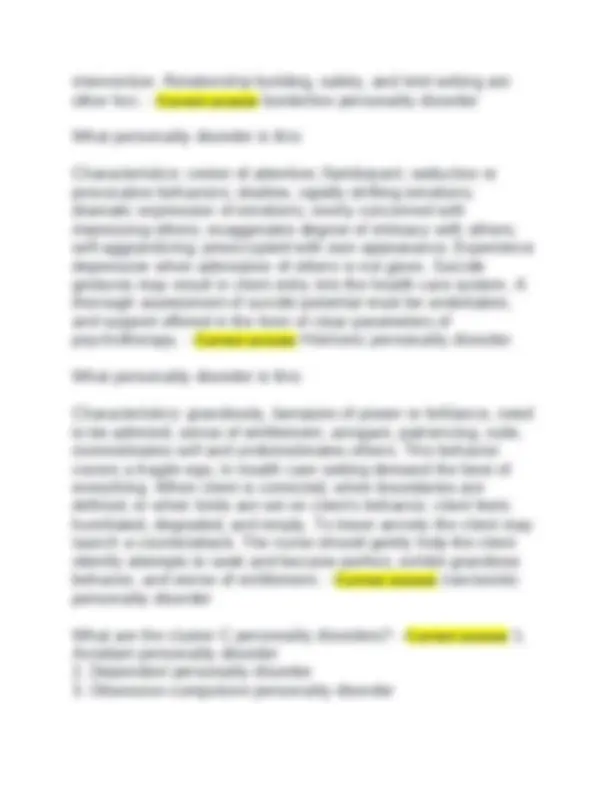
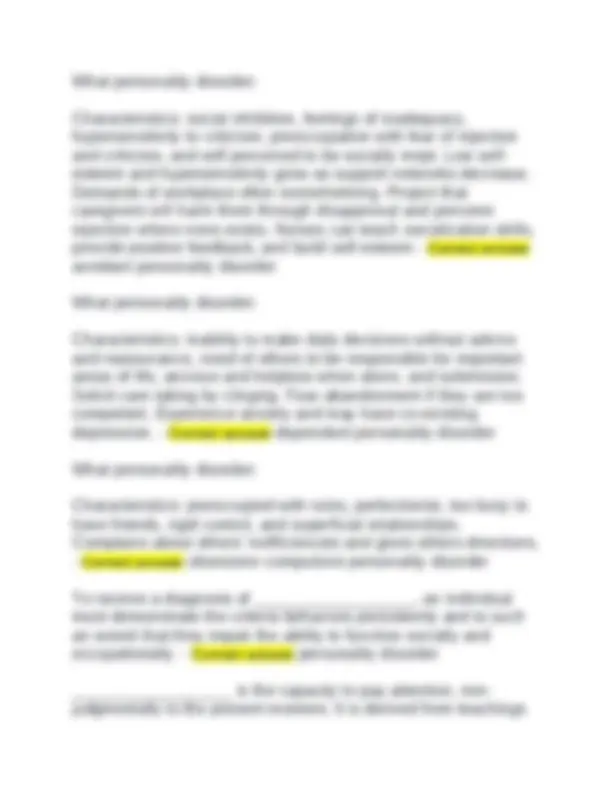
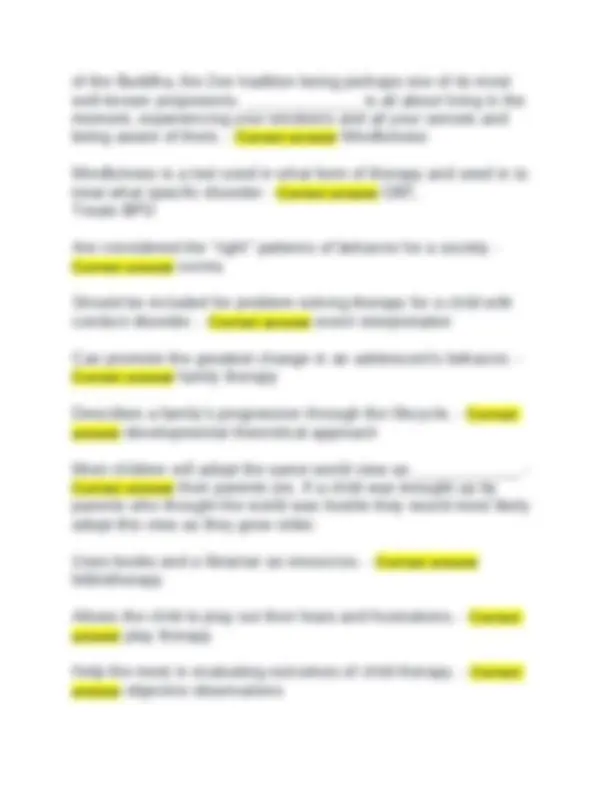
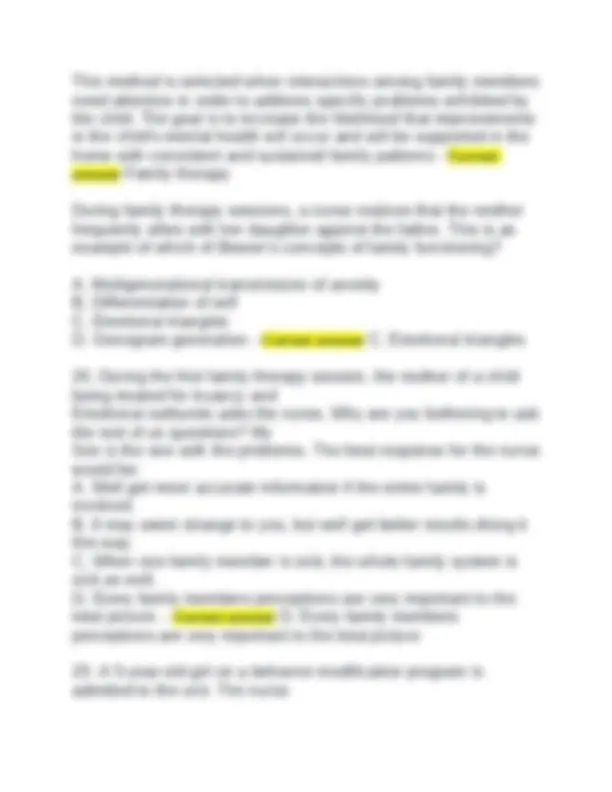
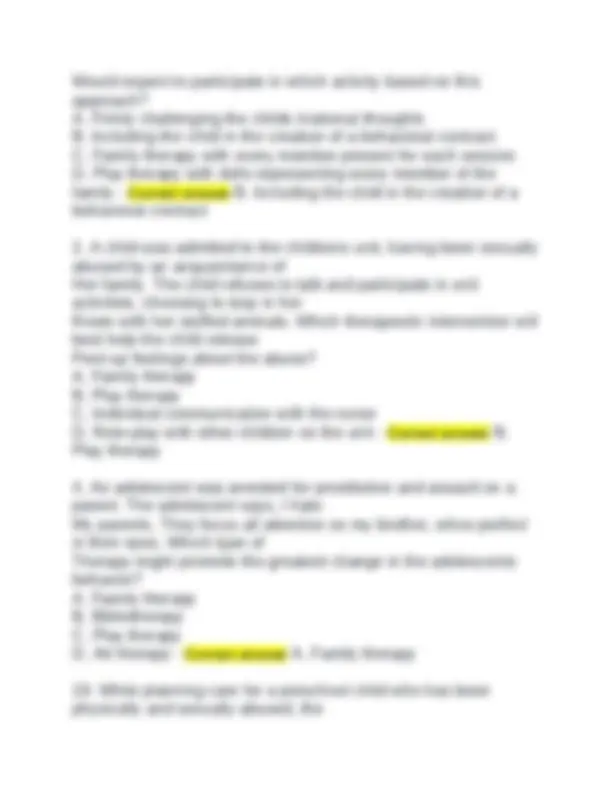
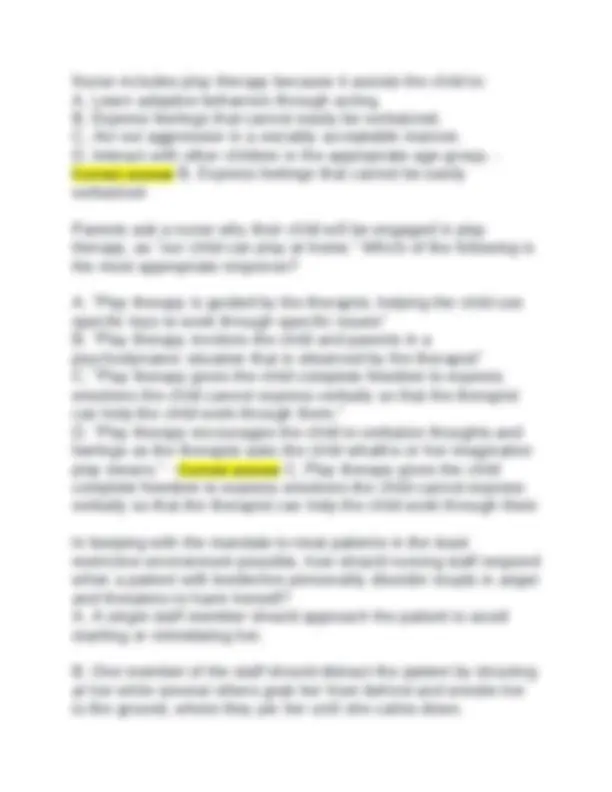
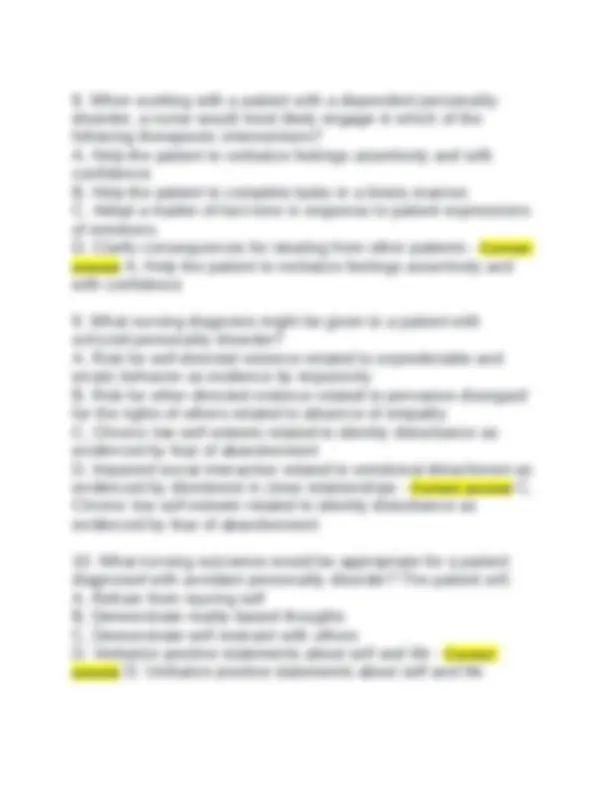
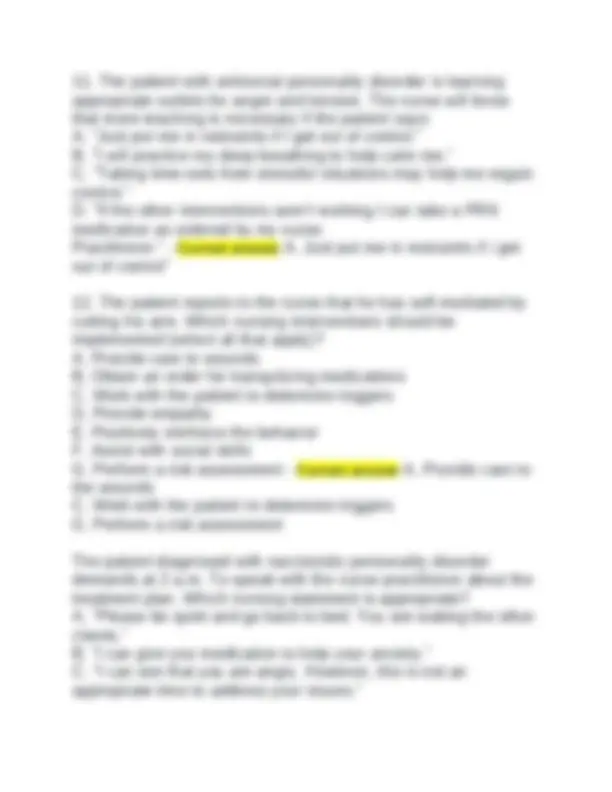
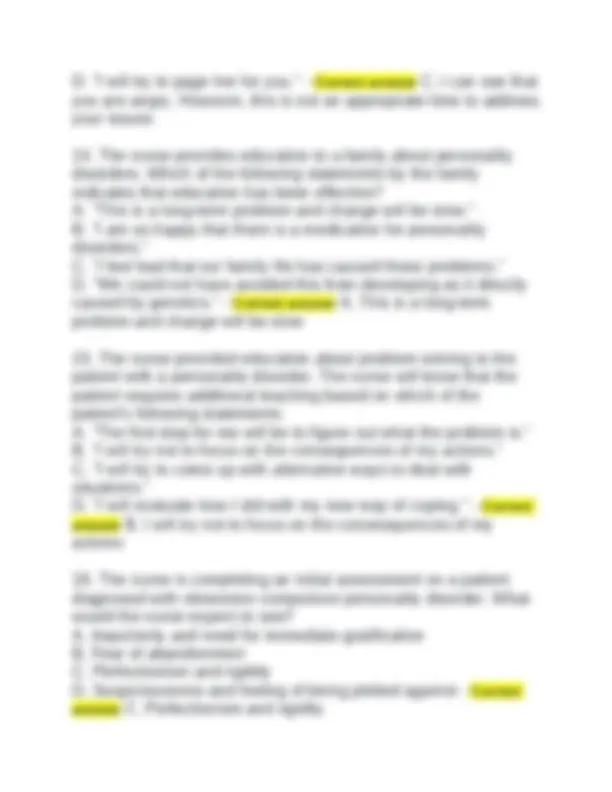
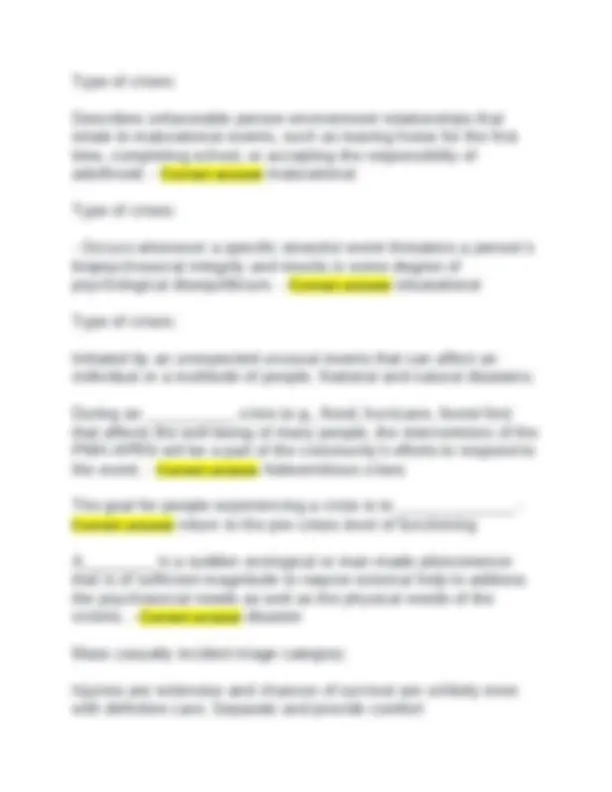
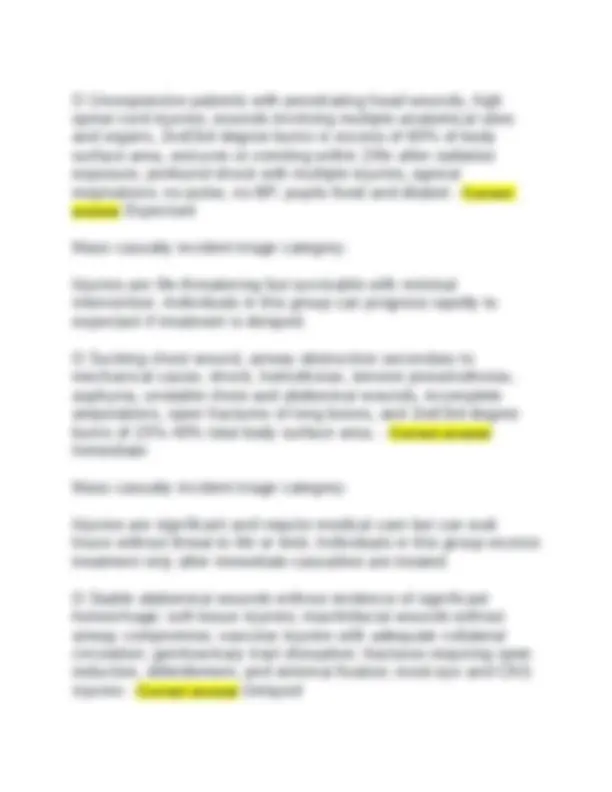
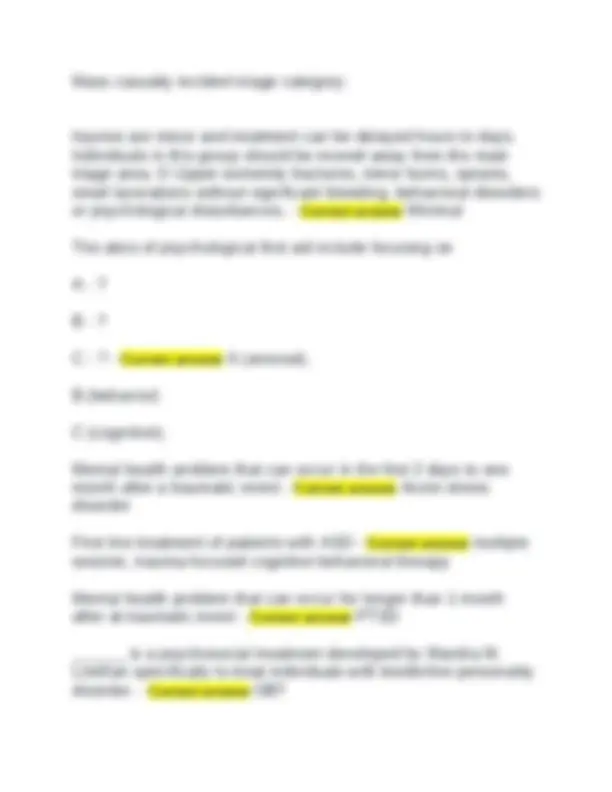
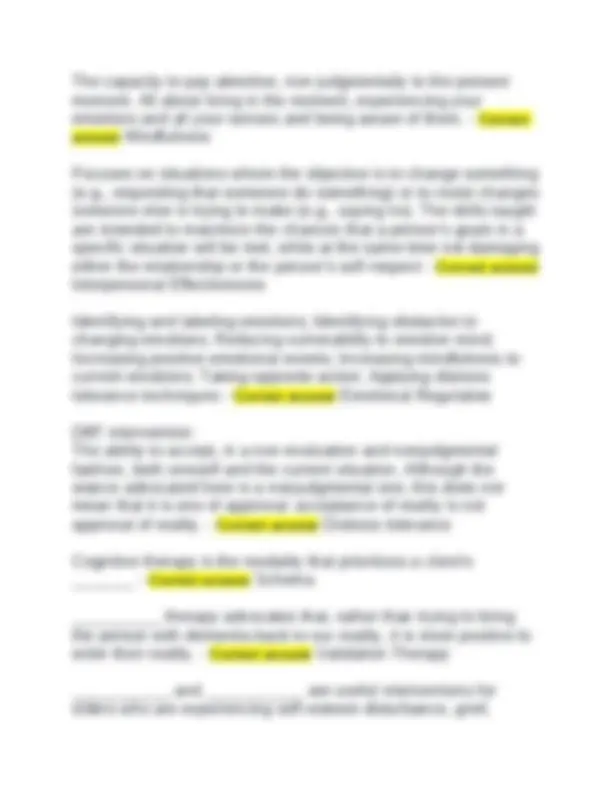
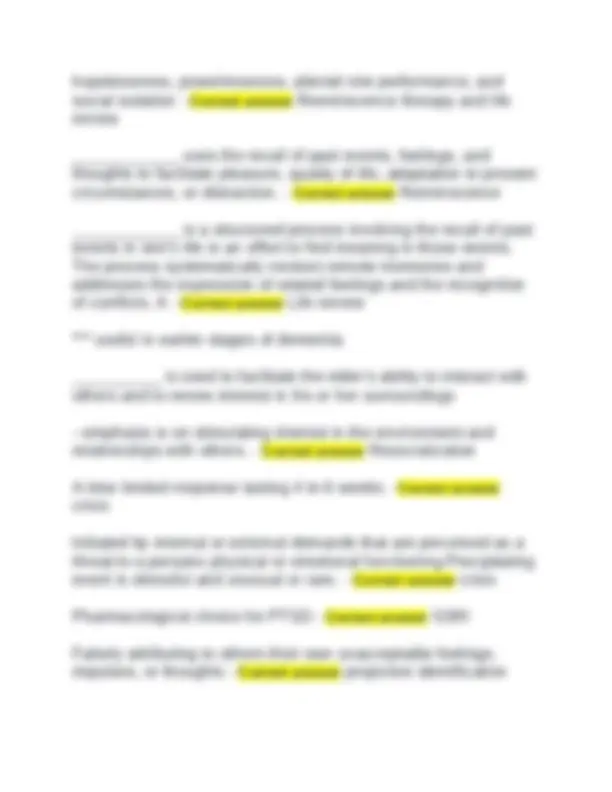
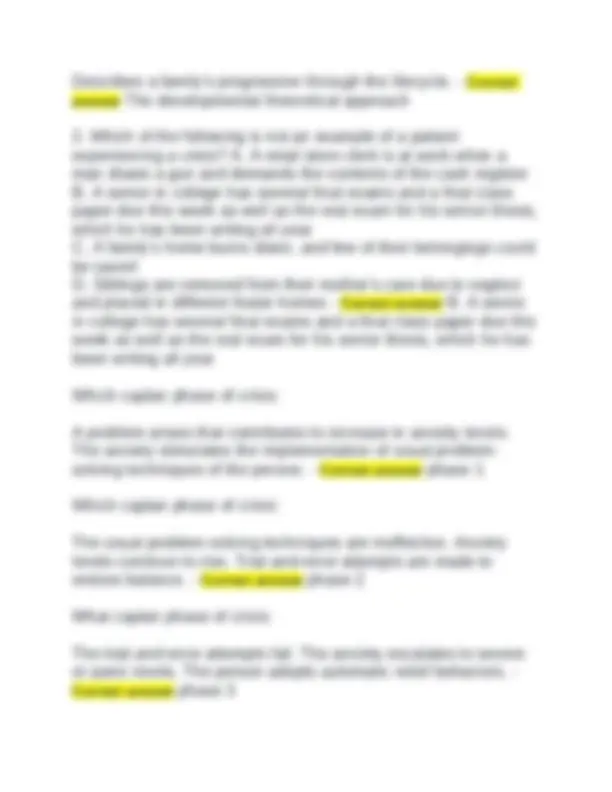
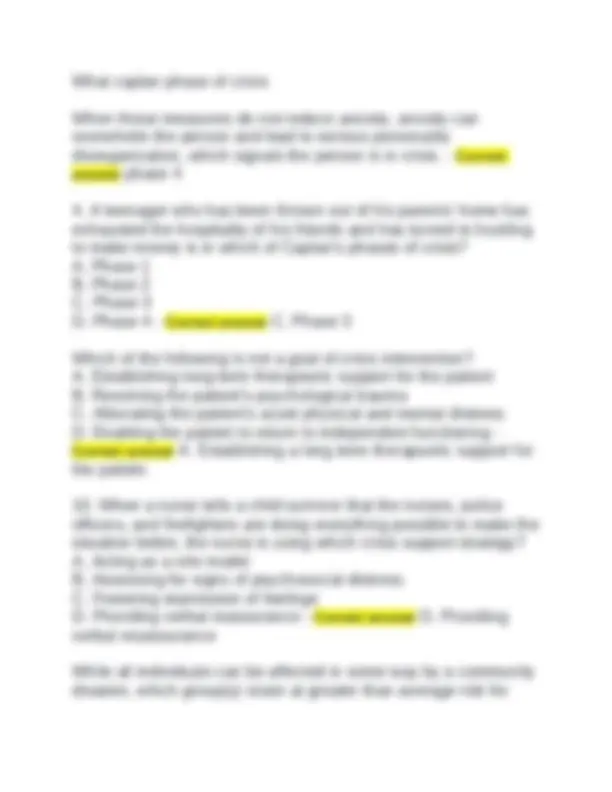
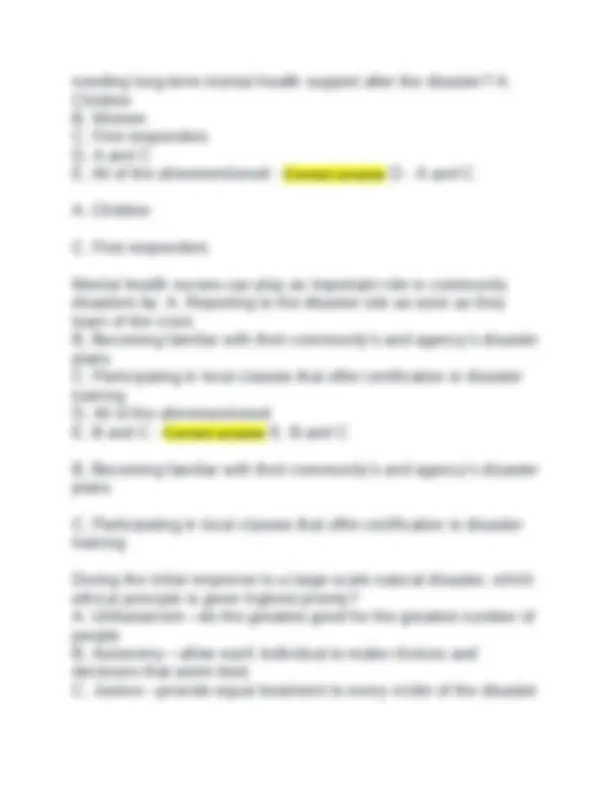
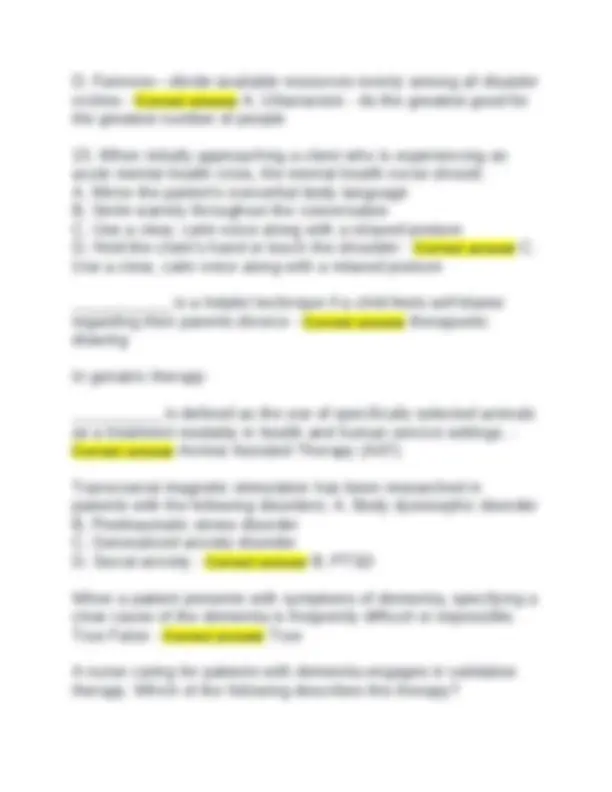
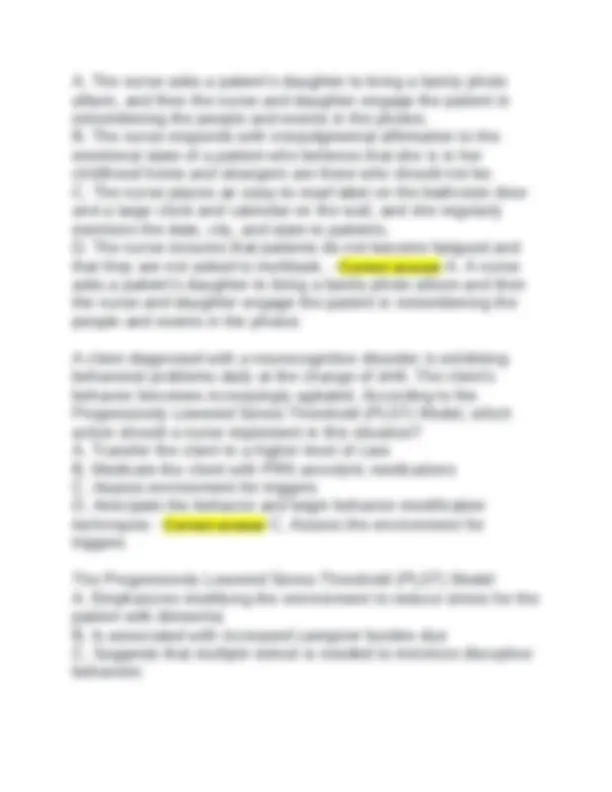
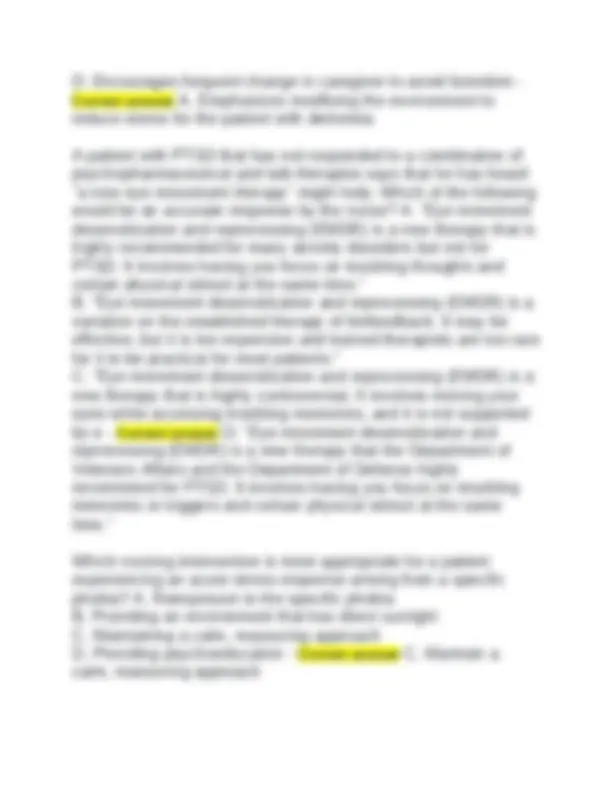
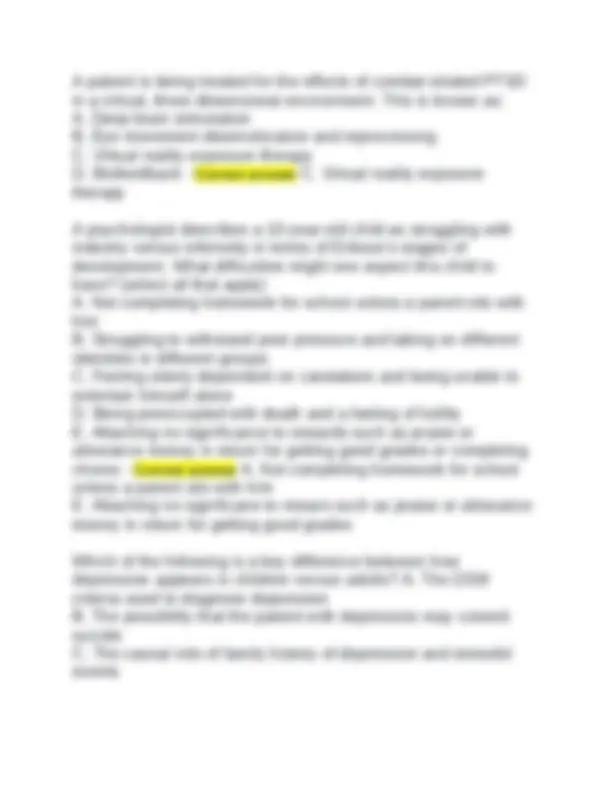
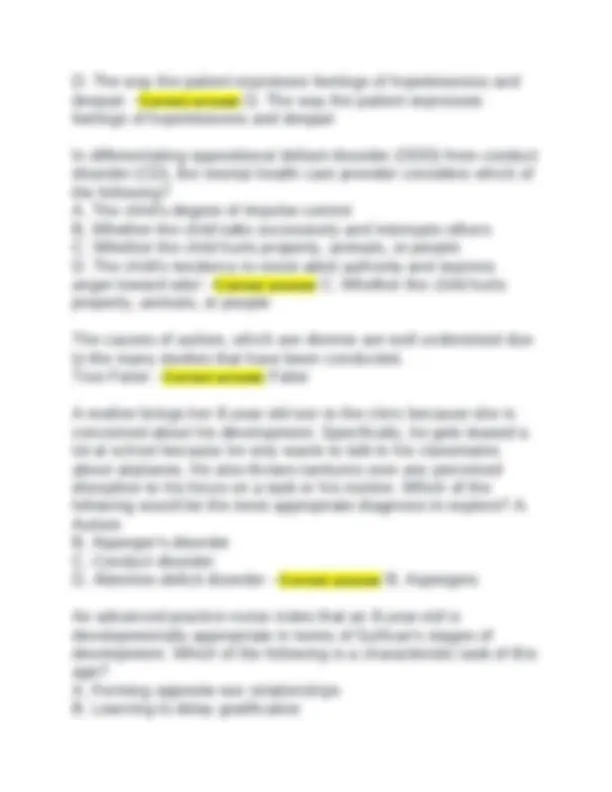
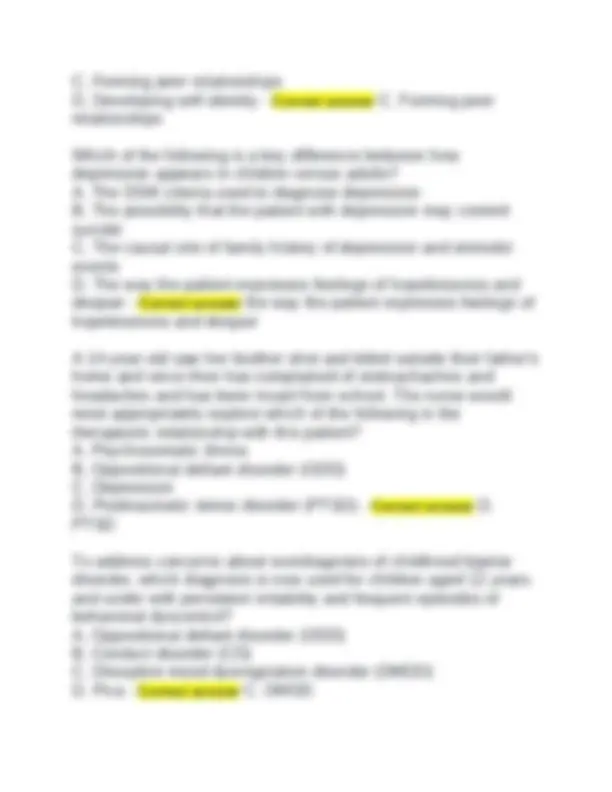
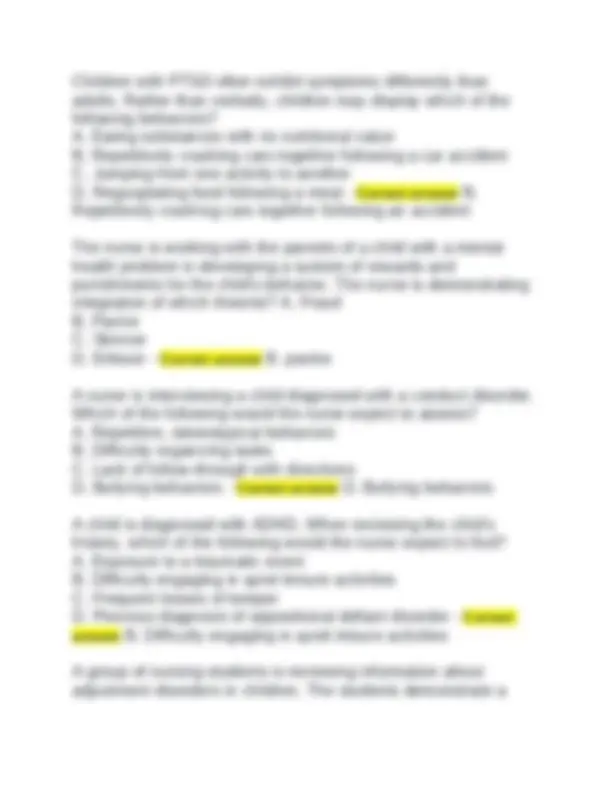
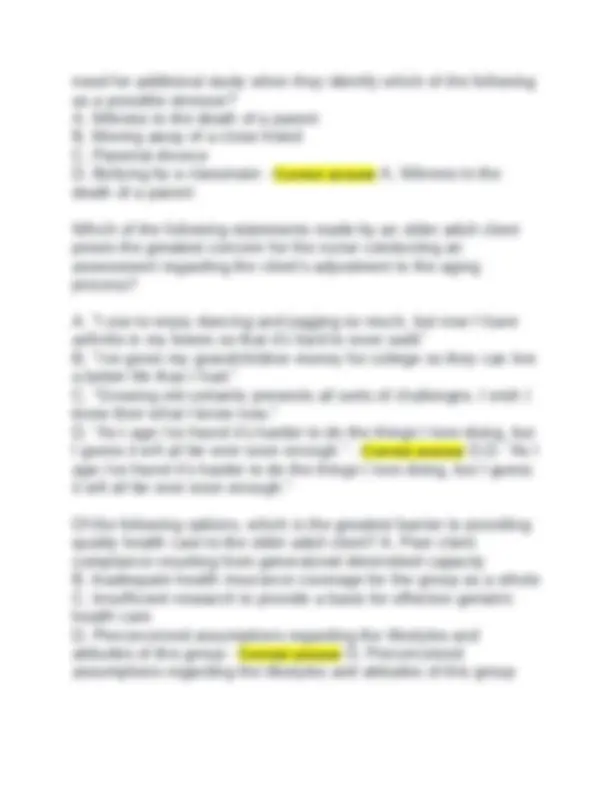
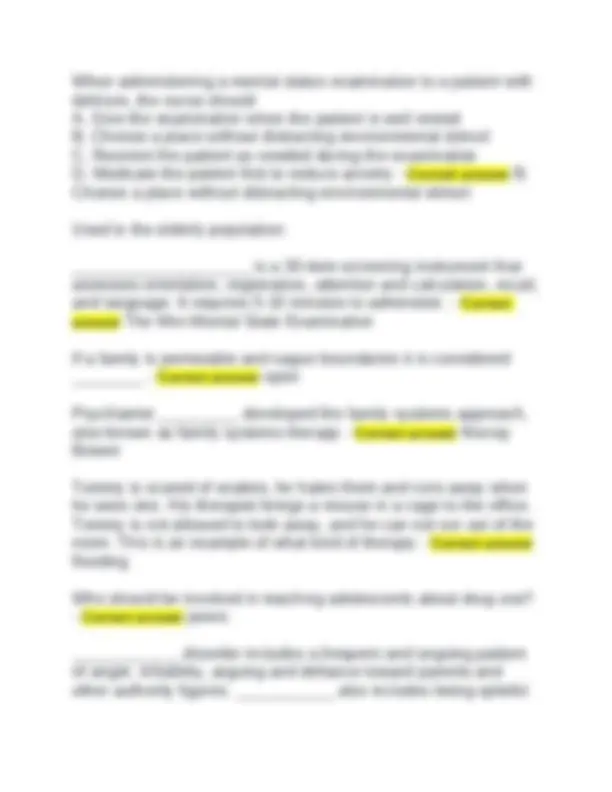
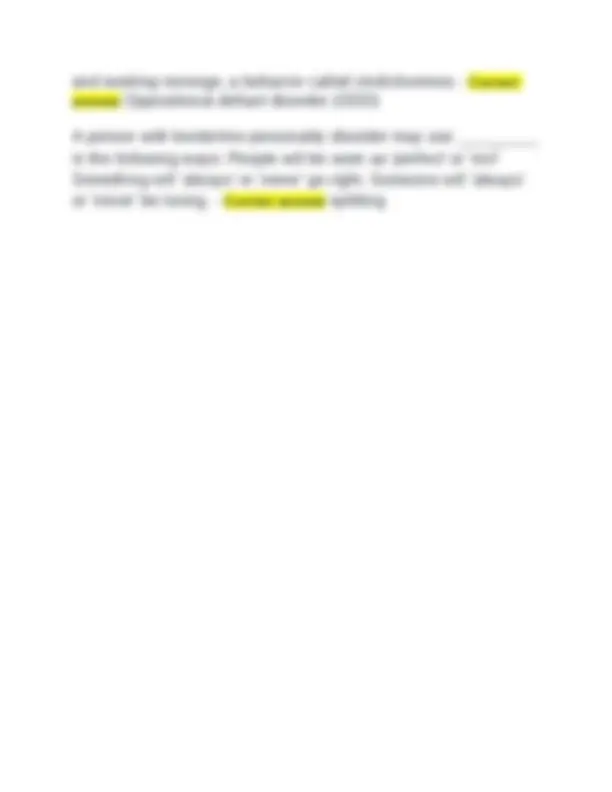


Study with the several resources on Docsity

Earn points by helping other students or get them with a premium plan


Prepare for your exams
Study with the several resources on Docsity

Earn points to download
Earn points by helping other students or get them with a premium plan
Community
Ask the community for help and clear up your study doubts
Discover the best universities in your country according to Docsity users
Free resources
Download our free guides on studying techniques, anxiety management strategies, and thesis advice from Docsity tutors
MH/PSYCH NP Clinical modal Exam 3 Questions and Answers.MH/PSYCH NP Clinical modal Exam 3 Questions and Answers.
Typology: Exams
1 / 35

This page cannot be seen from the preview
Don't miss anything!




























How many stages are in Piaget's developmental theory? - Correct answer four stages What personality disorder: Characteristics: suspicious of others; fear others will exploit, harm, or deceive them; fear of confiding in others (fear personal information will be used against them); misread compliments as manipulation; hypervigilant; prone to counterattack; hostile; and aloof. Psychotic episodes may occur in times of stress. Nurses should give straightforward explanations of tests, history taking, and procedures, side effects of drugs, changes in treatment plan, and possible further procedures, to counteract client fear. - Correct answer Paranoid personality disorder What personality disorder: Characteristics: avoids close relationships, is socially isolated, has poor occupational functioning, and appears cold, aloof, and detached. Social awareness is lacking and relationships generate fear and confusion in the client. Nurses should strive for simplification and clarity to help decrease client anxiety. - Correct answer Schizoid personality disorder What personality disorder: Characteristics: ideas of reference; magical thinking or odd beliefs; perceptual distortions; vague, stereotyped speech; frightened, suspicious, blunted affect; distant and strained social
relationships. These clients tend to be frightened and suspicious in social situations. Explanations can ease their anxiety. - Correct answer schizotypal personality disorder What are the cluster A personality disorders - Correct answer 1. Paranoid personality disorder
What personality disorder: Characteristics: social inhibition, feelings of inadequacy, hypersensitivity to criticism, preoccupation with fear of rejection and criticism, and self perceived to be socially inept. Low self- esteem and hypersensitivity grow as support networks decrease. Demands of workplace often overwhelming. Project that caregivers will harm them through disapproval and perceive rejection where none exists. Nurses can teach socialization skills, provide positive feedback, and build self-esteem - Correct answer avoidant personality disorder What personality disorder: Characteristics: inability to make daily decisions without advice and reassurance, need of others to be responsible for important areas of life, anxious and helpless when alone, and submissive. Solicit care taking by clinging. Fear abandonment if they are too competent. Experience anxiety and may have co-existing depression. - Correct answer dependent personality disorder What personality disorder: Characteristics: preoccupied with rules, perfectionist, too busy to have friends, rigid control, and superficial relationships. Complains about others' inefficiencies and gives others directions.
of the Buddha, the Zen tradition being perhaps one of its most well-known proponents. _____________ is all about living in the moment, experiencing your emotions and all your senses and being aware of them. - Correct answer Mindfulness Mindfulness is a tool used in what form of therapy and used in to treat what specific disorder - Correct answer DBT, Treats BPD Are considered the "right" patterns of behavior for a society - Correct answer norms Should be included for problem-solving therapy for a child with conduct disorder. - Correct answer event interpretation Can promote the greatest change in an adolescent's behavior. - Correct answer family therapy Describes a family's progression through the lifecycle. - Correct answer developmental theoretical approach Most children will adopt the same world view as ____________ - Correct answer their parents (ex. If a child was brought up by parents who thought the world was hostile they would most likely adopt this view as they grow older. Uses books and a librarian as resources. - Correct answer bibliotherapy Allows the child to play out their fears and frustrations. - Correct answer play therapy Help the most in evaluating outcomes of child therapy. - Correct answer objective observations
BPD: A major defense is _________ (alternating between idealizing and devaluing). - Correct answer splitting Stored bodies of knowledge that interact with incoming information to influence selective attention and memory search - Correct answer schemas An expressive therapy which involves using child and adolescent literature to help the child express feelings in a supportive environment, gain insight into feelings and behavior, and learn new ways to cope with difficult situations. - Correct answer bibliotherapy Form of therapy : Child-centered and typically builds on the foundation of the psychodynamic, object-relations, and attachment theories. - Correct answer play therapy When does play therapy start? (what age) - Correct answer Age 3 In children this form of therapy is useful for: Posttraumatic stress disorder, disruptive behavior disorders, mood disorders, and reactive attachment disorder. - Correct answer play therapy Is normally viewed as the best way to begin play therapy. Structured play is rarely used until nondirective play has enabled a full assessment of relevant themes and issues, and the child's trust around anxiety-laden issues has been developed. - Correct answer nondirective play _____________ in play therapy such as aggressive behavior toward a father doll) can have several meanings and should never be interpreted in a standardized fashion - Correct answer symbols
This method is selected when interactions among family members need attention in order to address specific problems exhibited by the child. The goal is to increase the likelihood that improvements in the child's mental health will occur and will be supported in the home with consistent and sustained family patterns - Correct answer Family therapy During family therapy sessions, a nurse realizes that the mother frequently allies with her daughter against the father. This is an example of which of Bowen's concepts of family functioning? A. Multigenerational transmission of anxiety B. Differentiation of self C. Emotional triangles D. Genogram generation - Correct answer C. Emotional triangles
Nurse includes play therapy because it assists the child to: A. Learn adaptive behaviors through acting. B. Express feelings that cannot easily be verbalized. C. Act out aggression in a sociably acceptable manner. D. Interact with other children in the appropriate age group. - Correct answer B. Express feelings that cannot be easily verbalized Parents ask a nurse why their child will be engaged in play therapy, as "our child can play at home." Which of the following is the most appropriate response? A. "Play therapy is guided by the therapist, helping the child use specific toys to work through specific issues" B. "Play therapy involves the child and parents in a psychodynamic situation that is observed by the therapist" C. "Play therapy gives the child complete freedom to express emotions the child cannot express verbally so that the therapist can help the child work through them." D. "Play therapy encourages the child to verbalize thoughts and feelings as the therapist asks the child whathis or her imaginative play means." - Correct answer C. Play therapy gives the child complete freedom to express emotions the child cannot express verbally so that the therapist can help the child work through them In keeping with the mandate to treat patients in the least restrictive environment possible, how should nursing staff respond when a patient with borderline personality disorder erupts in anger and threatens to harm herself? A. A single staff member should approach the patient to avoid startling or intimidating her. B. One member of the staff should distract the patient by shouting at her while several others grab her from behind and wrestle her to the ground, where they pin her until she calms down.
C. Several staff members should approach the patient and ask firmly that she adhere to behavioral guidelines; if she does not, she should be placed in wrist and ankle restraints and released when the nurse in charge determines the patient is no longer at risk. D. Several staff members should approach the patient and make clear they will not allow her to harm herself; if she does not de- escalate her behavior, she shou - Correct answer D. Several staff members should approach the patient and make clear they will not allow her to harm herself; if she does not de-escalate her behavior, she should be placed in restraints or seclusion sufficient to ensure her safety, and the nurse should obtain and order for a restraint
O Unresponsive patients with penetrating head wounds, high spinal cord injuries, wounds involving multiple anatomical sites and organs, 2nd/3rd degree burns in excess of 60% of body surface area, seizures or vomiting within 24hr after radiation exposure, profound shock with multiple injuries, agonal respirations; no pulse, no BP, pupils fixed and dilated - Correct answer Expectant Mass casualty incident triage category: Injuries are life-threatening but survivable with minimal intervention. Individuals in this group can progress rapidly to expectant if treatment is delayed. O Sucking chest wound, airway obstruction secondary to mechanical cause, shock, hemothorax, tension pneumothorax, asphyxia, unstable chest and abdominal wounds, incomplete amputations, open fractures of long bones, and 2nd/3rd degree burns of 15%-40% total body surface area. - Correct answer Immediate Mass casualty incident triage category: Injuries are significant and require medical care but can wait hours without threat to life or limb. Individuals in this group receive treatment only after immediate casualties are treated. O Stable abdominal wounds without evidence of significant hemorrhage; soft tissue injuries; maxillofacial wounds without airway compromise; vascular injuries with adequate collateral circulation; genitourinary tract disruption; fractures requiring open reduction, débridement, and external fixation; most eye and CNS injuries - Correct answer Delayed
Mass casualty incident triage category: Injuries are minor and treatment can be delayed hours to days. Individuals in this group should be moved away from the main triage area. O Upper extremity fractures, minor burns, sprains, small lacerations without significant bleeding, behavioral disorders or psychological disturbances. - Correct answer Minimal The abcs of psychological first aid include focusing on A -? B -? C -? - Correct answer A (arousal), B (behavior) C (cognition). Mental health problem that can occur in the first 2 days to one month after a traumatic event - Correct answer Acute stress disorder First line treatment of patients with ASD - Correct answer multiple session, trauma-focused cognitive behavioral therapy Mental health problem that can occur for longer than 1 month after at traumatic event - Correct answer PTSD ______ is a psychosocial treatment developed by Marsha M. Linehan specifically to treat individuals with borderline personality disorder. - Correct answer DBT